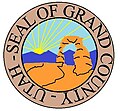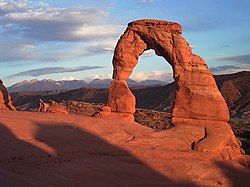Grand County, Utah | |
|---|---|
 Grand County Courthouse, June 2014 | |
 Location within the U.S. state of Utah | |
 Utah's location within the U.S. | |
| Coordinates: 38°59′N109°34′W / 38.99°N 109.56°W | |
| Country | |
| State | |
| Founded | March 13, 1890 |
| Named after | Grand River (now the Colorado River) |
| Seat | Moab |
| Largest city | Moab |
| Area | |
• Total | 3,684 sq mi (9,540 km2) |
| • Land | 3,672 sq mi (9,510 km2) |
| • Water | 12 sq mi (31 km2) 0.3% |
| Population (2020) | |
• Total | 9,669 |
| 9,788 | |
| • Density | 2.633/sq mi (1.017/km2) |
| Time zone | UTC−7 (Mountain) |
| • Summer (DST) | UTC−6 (MDT) |
| Congressional district | 3rd |
| Website | www |
Grand County is a county on the east central edge of the U.S. state of Utah, United States. As of the 2020 United States census, the population was 9,669. [2] Its county seat and largest city is Moab. [3]
Contents
- History
- Geography
- Airport
- Major highways
- Adjacent counties
- Protected areas
- Lakes and reservoirs
- Demographics
- 2020 census
- Religion
- Politics and government
- Sagebrush Rebellion
- Paleontology
- Communities
- Cities
- Towns
- Census-designated places
- Unincorporated communities
- Former communities
- See also
- Notes
- References
- Further reading
- External links
Grand County is home to one of the nine statewide regional campuses of Utah State University (located in the city of Moab) and serves as a gateway to both Arches and Canyonlands National Parks.




